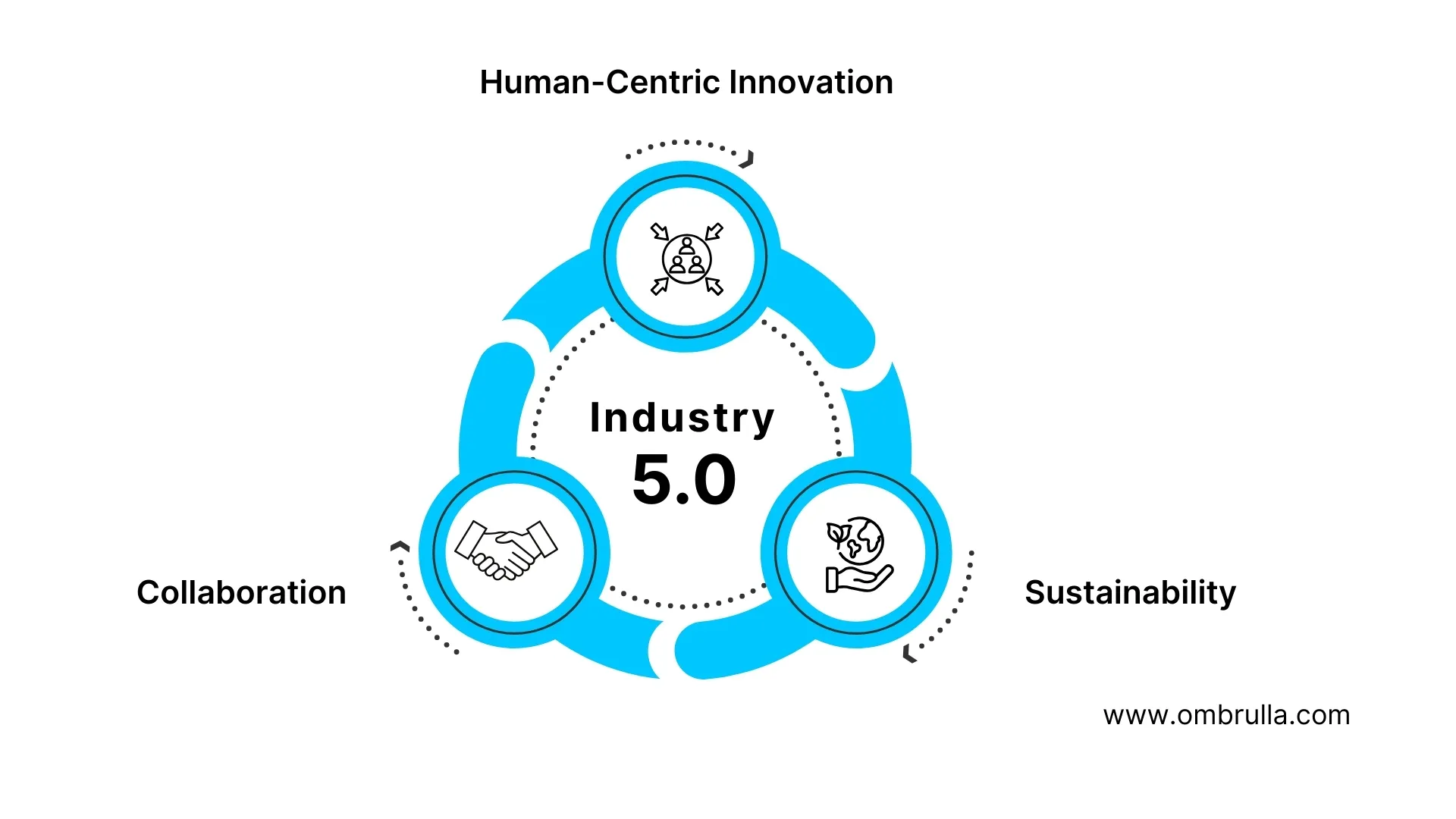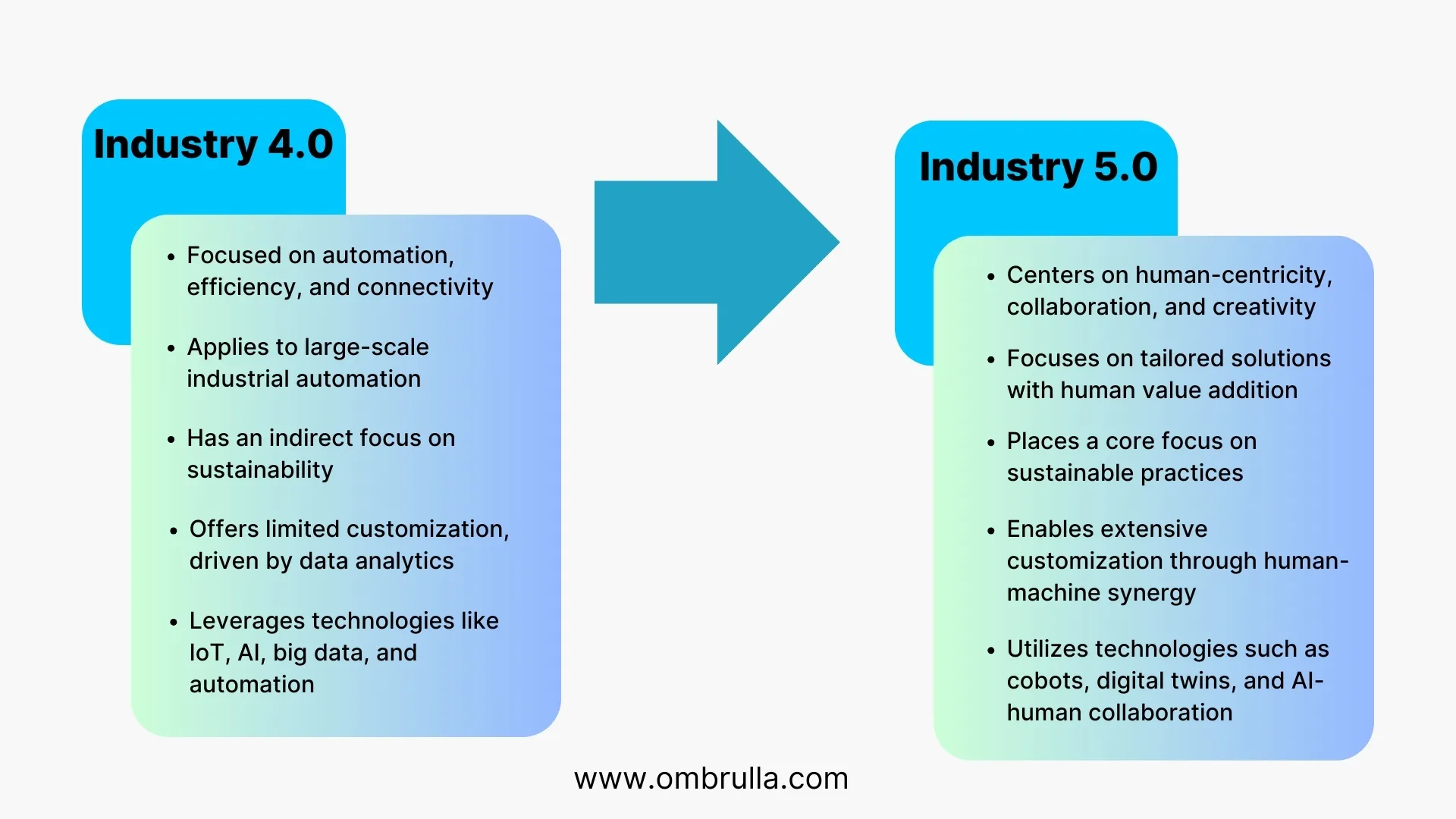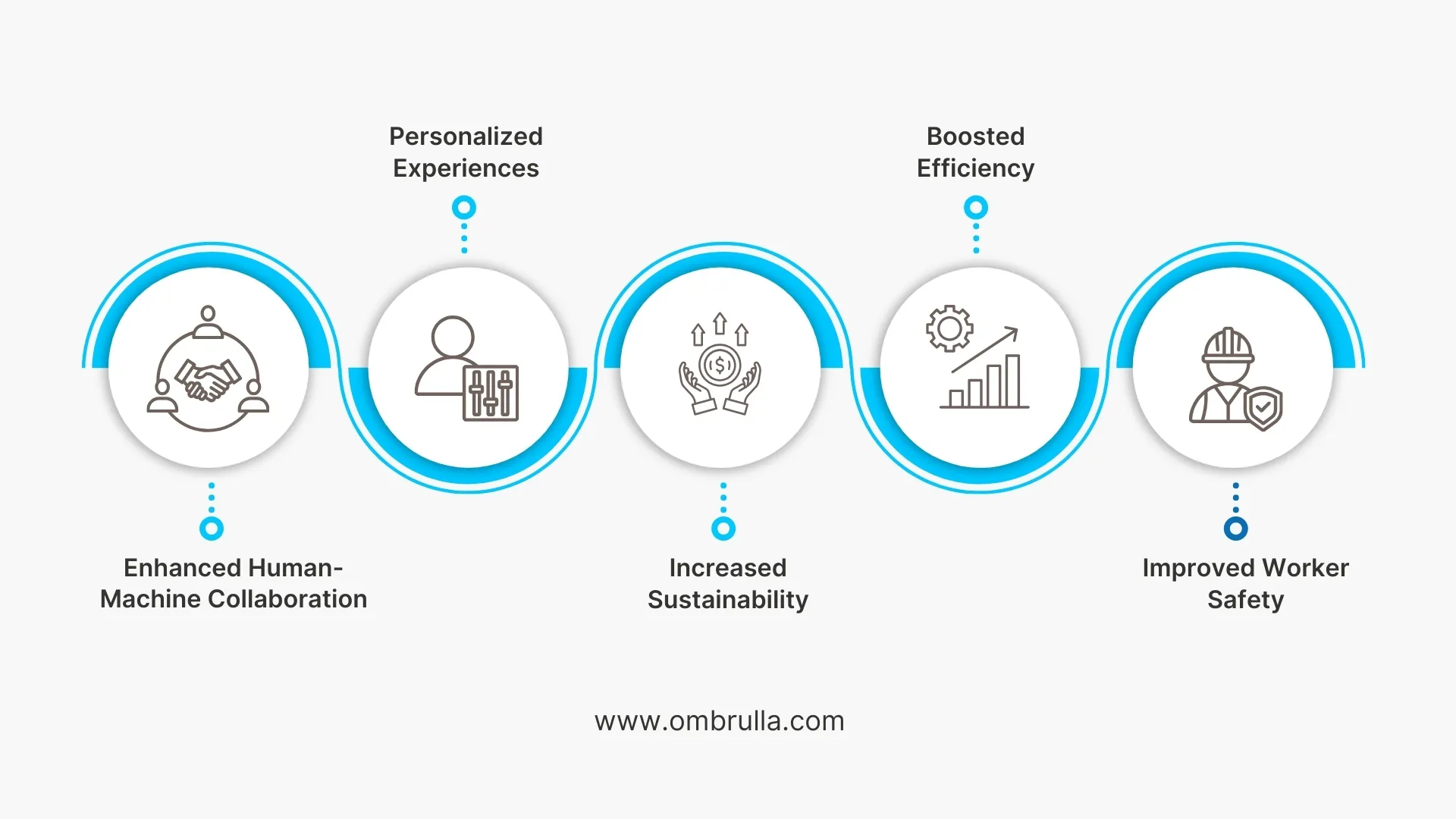Introduction
The term industrial revolution traditionally invokes images of steam engines, factories, and assembly lines. However, the concept has transcended these historical roots, becoming a dynamic process that continues to evolve with technological advancements. Industry 5.0 is the latest phase in this ongoing transformation, marked by the convergence of AI, IoT, and human ingenuity.
In this blog, we will delve into the evolution of industrial revolutions, understand the key pillars of Industry 5.0, and explore its strategies, applications, and future.
What is Industry 5.0?
Industry 5.0 emphasizes a human-centric approach, blending technological advancements with ethical and sustainable practices. It aims to create value for industries while prioritizing human creativity, well-being, and societal benefits.Unlike Industry 4.0, which prioritizes efficiency and automation, Industry 5.0 focuses on adding a human touch to technological advancements.
Three Pillars of Industry 5.0

• Human-Centric Innovation
Focuses on creating technologies that enhance human experiences.
• Sustainability
Ensures eco-friendly practices and reduces environmental impact.
• Collaboration
Promotes synergy between humans, machines, and organizations for optimized outcomes.
Comparison of Industry 4.0 and Industry 5.0

Comparison of Industry 4.0 and Industry 5.0The shift from Industry 4.0 to Industry 5.0 marks a move from automation and IoT to a more human-centered approach. While Industry 4.0 focuses on data and efficiency, Industry 5.0 integrates human creativity with advanced technologies like AI and robotics, fostering personalization, sustainability, and collaboration.
Benefits of Industry 5.0
Industry 5.0 marks a significant shift from purely automation-driven systems to a more human-centered approach, where humans and machines work together to enhance productivity, innovation, and sustainability. The integration of advanced technologies like Artificial Intelligence (AI), Internet of Things (IoT), and collaborative robots (cobots) with human intelligence creates numerous benefits for industries across the globe. Here's a detailed look at the key benefits of Industry 5.0

Enhanced Human-Machine Collaboration
Industry 5.0 fosters seamless collaboration, allowing humans to focus on creative and strategic roles while machines handle repetitive tasks, boosting productivity and innovation.
Personalization at Scale
AI and data analytics enable real-time customer insights, allowing businesses to deliver customized products and services, enhancing customer satisfaction and loyalty.
Increased Sustainability
Advanced technologies optimize resource use, reduce waste, and minimize energy consumption, helping companies lower their environmental impact and carbon footprint with an enhanced operational sustainability.
Enhanced Productivity and Efficiency
AI and machine learning improve decision-making, predict maintenance needs, and streamline workflows, leading to reduced downtime, better asset utilization, and efficient production.
Improved Worker Safety and Health
Cobots handle hazardous tasks, while IoT devices monitor worker health, reducing risks and ensuring a safer work environment.
Industry 5.0's focus on human-centric technology enhances innovation, sustainability, and operational efficiency.
Integrating Industry 5.0 into Industry 4.0 Technologies
Industry 5.0 builds on the technological advancements of Industry 4.0, focusing on a human-centric approach that enhances collaboration between humans and machines. By integrating human creativity with smart automation, Industry 5.0 optimizes productivity while retaining human involvement. Here's how it works:
Customizing Human/Machine Interactions
Using embedded sensors and machine learning, collaborative robots (cobots) adapt to human behavior, enhancing flexibility and reducing errors. This ensures a smoother, more intuitive interaction between workers and machines.
AI-Powered Human/Robot Collaboration
AI optimizes human-robot collaboration, reducing waste and improving efficiency. Robots equipped with AI can adapt based on real-time feedback, improving sustainability and ensuring resource optimization.
Advanced Data Management
AI and machine learning analyze data to minimize inefficiencies, providing actionable insights for humans to optimize operations. By automating routine tasks, AI empowers workers to focus on creative and strategic roles.
Simulation Models and Digital Twins
Digital twins and simulation models replicate real-world systems, enabling businesses to test processes safely. This reduces operational risks, improves performance, and supports predictive maintenance.
Collaborative Robots and Virtual Reality (VR)
Cobots handle repetitive tasks, freeing human workers for strategic roles. VR tools enhance training and decision-making, enabling innovative solutions and improved efficiency in operations.
Collaboration of Humans and Robots: Collaborative Robots (Cobots)
Collaborative robots (cobots) are transforming the workplace by combining human intelligence with robotic precision. Unlike traditional robots, cobots work alongside humans, handling repetitive, hazardous, or strenuous tasks while allowing workers to focus on creative and strategic roles. This integration enhances productivity, safety, and job satisfaction, making cobots a key feature of Industry 5.0.
1. Handling Repetitive and Hazardous Tasks
Cobots excel at performing monotonous or physically demanding tasks, such as assembly, quality control, and packaging. They also take over dangerous jobs, like lifting heavy objects or working with hazardous materials, reducing the risk of workplace injuries and allowing humans to focus on more complex tasks.
2. Improving Workplace Safety
Cobots enhance safety by minimizing human involvement in high-risk tasks. Equipped with advanced sensors, they can detect human presence and stop to prevent accidents. This technology helps reduce injury rates and worker fatigue, improving overall safety and productivity.
3. Fostering Creativity and Strategic Thinking
By handling routine tasks, cobots free human workers to engage in creative and strategic roles that require problem-solving and innovation. In R&D or customer service, workers can focus on high-value activities while cobots handle repetitive administrative tasks.
4. Cobots in Industry 5.0
Cobots are central to Industry 5.0, which emphasizes human-centric innovation. While Industry 4.0 focused on automation for efficiency, Industry 5.0 integrates technology to enhance human creativity and collaboration. Cobots complement human abilities, creating a more flexible, innovative, and productive work environment.
How Industry 5.0 is Revolutionizing Business Strategies
Industry 5.0 is reshaping the way businesses operate by merging advanced technology with a human-centric approach. It goes beyond the automation of Industry 4.0, emphasizing collaboration between humans and machines to drive innovation, adaptability, and sustainability. Here's how Industry 5.0 is transforming business strategies:
Personalization
Advanced technologies like AI, IoT, and big data analytics help businesses understand customer preferences deeply, enabling the creation of highly tailored products and services. This enhances satisfaction and loyalty, providing a competitive edge.
Agility
Shifting market demands and rapid technological advancements require agility. Tools like real-time data and AI-driven analytics empower businesses to anticipate trends, streamline decisions, and adapt strategies quickly.
Innovation
By automating repetitive tasks, machines allow human talent to focus on creativity, problem-solving, and strategic thinking. This collaboration fosters groundbreaking ideas and drives new growth opportunities.
Sustainability
Eco-friendly practices are supported by AI, which minimizes waste, optimizes resource use, and reduces energy consumption. Technologies like digital twins ensure efficiency while meeting environmental goals.
By integrating these principles, Industry 5.0 redefines business strategies to create a future where innovation, adaptability, and sustainability thrive together.
AI Software Development: A Catalyst for Advancing Industry 5.0
AI software development plays a crucial role in Industry 5.0 by enhancing collaboration between humans and machines. It automates routine tasks, augments human decision-making, and drives innovation through technologies like predictive analytics and real-time data processing. This enables businesses to optimize resources, deliver personalized services, and adapt quickly to market changes while keeping human creativity at the core of operations.
Furthermore, AI enables advanced solutions such as digital twins, allowing businesses to simulate and optimize processes for better performance and sustainability. By integrating AI, Industry 5.0 fosters a human-centric, technology-driven future, where innovation, efficiency, and sustainability thrive together.
The Future of Industry 5.0
The future of industrial transformation lies in merging advanced technologies with human creativity and values. Businesses will offer highly personalized solutions, using AI, IoT, and data analytics to tailor products and services to individual customer needs in real time. Sustainability will become a key focus, with green technologies such as IoT-enabled systems and AI-driven energy optimization driving operations that minimize waste, reduce carbon footprints, and promote efficiency and environmental responsibility.
This evolution will foster innovation by combining human ingenuity with machine precision. Collaborative robots (cobots) and AI-driven tools will handle routine tasks, allowing workers to focus on strategic thinking and problem-solving. This synergy will enhance productivity, spark groundbreaking ideas, and help industries tackle global challenges with a human-centric, sustainable approach. Ultimately, this transformation aims to create a future where technology empowers humanity, driving both progress and positive change.
Conclusion
Industry 5.0 blends human creativity with advanced technologies like AI, IoT, and cobots to create a sustainable, resilient industrial landscape. Prioritizing well-being and personalization, it goes beyond efficiency to foster human-machine collaboration. Embracing this shift is essential for innovation, sustainability, and addressing global challenges like climate change and workforce well-being.





